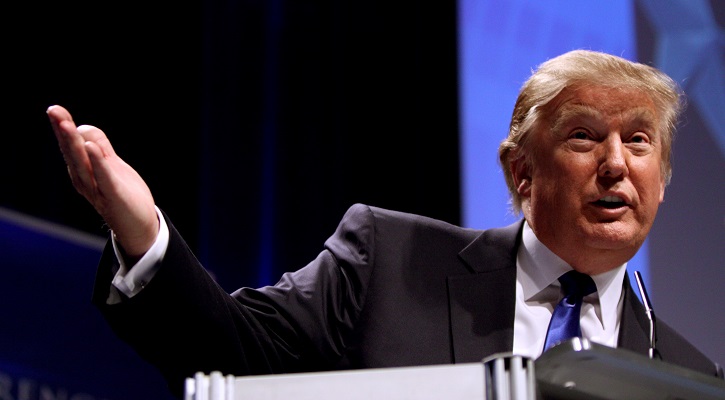On Tuesday, we saw how United States President Donald Trump’s tweeting can influence legislative decisions when his caused House Republicans to backtrack on their plans to reduce the autonomy of the Office of Congressional Ethics. Could he penchant for using social media also impact the military’s defence procurement?
In what has been observed the Index Journal as “defence-policy-by-Twitter,” Trump announced that he had asked Boeing to pitch an F-18 Super Hornet which could compete with the F-35 Joint Strike Fighter (JSF) from Lockheed Martin.
Based on the tremendous cost and cost overruns of the Lockheed Martin F-35, I have asked Boeing to price-out a comparable F-18 Super Hornet!
— Donald J. Trump (@realDonaldTrump) December 22, 2016
Could this be a call for proposal via Twitter?
“based on the tremendous cost and cost overruns of the Lockheed Martin F-35, I have asked Boeing to price-out a comparable F/A 18 Super Hornet”, Trump tweeted on December 22nd.
He also called the F-35 “…a disaster, it’s totally out of control.”
This may be good news for Boeing in that president-elect appears to be giving the company another chance to offer its aircraft to the US Armed Forces.
Related Content
Liberals announce ‘interim purchase’ of 18 Boeing Super Hornets
F-35A declared ‘combat ready’ by USAF
The military needs new fighter jets now – Sajjan
The F-35 Lightning is descended from the X-35, which was the winning design of the JSF program. The fifth generation fighter beat out Boeing’s X-32.
However, Trump’s tweet may have imperiled the future of the U.S. F-35 program. Already, his implied threat of canceling the program has hurt Lockheed Martin financially. Trump’s tweet is being credited for causing the value of Lockheed Martin shares to plummet by almost US$S2 billion.
On the hand, Boeing shares rose o.5 per cent after the tweet.
Early on, Trump has made it very clear that he thought the F-35 program was too expensive.
Lockheed’s F-35 is meant to replace older planes including Boeings F/A-18 and become the backbone of the Air Force, Marine Corps, and Navy’s fighter jet squadrons. More than 2,400 F-35s will be built for the U.S. and allied forces.
In the last 10 fiscal years, the F-35 program has had $81 billion in obligations, with the fiscal 2017 defense authorization allowing an additional $9.9 billion, according to the Seattle Times.
Costing $1.5 trillion, by some estimates, the JSF program is the biggest defence contract that U.S. defence contract the U.S. has signed. Yet, the program has been plagued by missed deadline, cost overruns and design defects.
The social media salvos from Trump may be an attempt to get Lockheed Martin to lower its price.
It just might be working.
LM CEO just had a good conversation with @RealDonaldTrump… she personally committed to drive down the cost of the F-35! pic.twitter.com/K2aK7pW07f
— Lockheed Martin (@LockheedMartin) December 23, 2016
A day after Trump took aim at the F-35’s price tag, Marillyn Hewson, CEO of Lockheed, told Reuters that she had spoken with the president-elect and had assured him that the company will continue efforts to reduce the price of its fighter jet.
Meanwhile, Boeing has also taken to Twitter announcing that it is ready to work with Trump in to “meet affordably meet U.S. military requirements.”
Ready to work with @realDonaldTrump's administration to affordably meet U.S. military requirements.
— The Boeing Company (@Boeing) December 22, 2016
However, at least one defence industry analyst is saying that Trump’s gambit could create unforeseen circumstances. Trump’s persistent use social media posts may also impact future policy decisions and other federal negotiations down the road.
“We have no idea how this plays out but believe ‘Twitter risk’ for defense companies could be a significant issue over the next four years,” Roman Schweizer, a defense analyst at the Cowan Research Group, told the St. Louise Post Dispatch.
Despite Trump’s tweets, some studies indicate the cost of the F-35 has been coming down since 2011.
Since the JSF projects reset in 2011, new management structures, budgets and projections now put the estimated procurement cost of the F-35 $133.1 million per aircraft in December 2015, down from $147.8 million per aircraft back in March 2012, according to the Australian Strategic Policy Institute’s analysis.
“The trends keep going down, with contracts for the next 42 F-35A’s at $US$102.1m each, a decrease of 5.5 per cent over the previous batch and a 60 per cent reduction over the first aircraft acquired,” to The Australian newspaper.
Trump is also making a mistake in comparing the Super Hornet to the F-35. The two are entirely different aircraft which were essentially designed 20 years apart and meant for divergent missions.
The F-35 is designed as a stealth aircraft with a very low radar signature – something the Super Hornet is not.
“There’s no such thing as a comparable F/A-18,” Marcus Weisgerber, global business editor at the online industry site Defense One and vice president of the Pentagon Press Association, told the Seattle Times.
The Super Hornet is less expensive (about half the price of an F-35), while the F-35 has stealth characteristics to better evade detection.
The Super Hornet was designed to land on aircraft carriers and engage enemy fighter jets so it is more heavily reinforced. While the Navy variant of the F-35 can land on carriers and the Marine version can land vertically, the aircraft is designed to be fast and lightweight and to engage the shoot down its enemy from afar before it can be spotted.
Boeing, however, might propose its Advanced Super Hornet concept as an alternative.
This is a concept that the company and Northrop Grumman launched back in 2013. Its prototype featured a 50 per cent reduction in frontal radar cross-section, conformal fuel tanks, and an enclosed weapons pod.
A newer design features upgrades such as a centerline fuel tank-mounted infrared search and track sensor, integrated defensive electronic countermeasures Block IV, active electronically scanned array radar and next-generation jammer.

